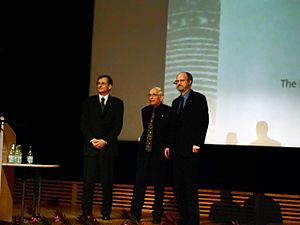Yves Chauvin facts for kids
Quick facts for kids
Yves Chauvin
|
|
|---|---|

Nobel Laureates in Chemistry 2005 on stage
|
|
| Born | 10 October 1930 Menen, Belgium
|
| Died | 27 January 2015 (aged 84) Tours, France
|
| Nationality | French |
| Education | École supérieure de chimie physique électronique de Lyon |
| Known for | Deciphering the process of olefin metathesis |
| Awards | Nobel Prize in Chemistry (2005) |
| Scientific career | |
| Institutions | French Institute of Petroleum |
Yves Chauvin (born October 10, 1930 – died January 27, 2015) was a famous French chemist. He won the Nobel Prize in Chemistry for his important work. He was a top research director at the French Institute of Petroleum and a member of the French Academy of Sciences. He became well-known for figuring out how a special chemical process called olefin metathesis works. He shared the Nobel Prize in 2005 with Robert H. Grubbs and Richard R. Schrock.
Contents
Early Life and Career
Yves Chauvin was born in Menen, Belgium, on October 10, 1930. His parents were French, and his father worked as an electrical engineer. In 1954, he finished his studies at the École supérieure de chimie physique électronique de Lyon.
He first worked in the chemical industry, but he wanted to do more exciting research. He once said that to find new things, you have to look for them. He believed it was worth taking risks to discover something new. In 1960, Chauvin started working for the French Institute of Petroleum in Rueil-Malmaison, France. He retired from the institute in 1995 but continued as an honorary research director. He also served as a retired director at the Lyon School of Chemistry, Physics, and Electronics.
Awards and Recognitions
In 2005, Yves Chauvin received the Nobel Prize in Chemistry. He shared this big award with Robert H. Grubbs and Richard R. Schrock. They were recognized for their work on olefin metathesis from the early 1970s.
Chauvin was a bit shy about getting the award at first. He even thought about not accepting it. However, he did receive his prize from the King of Sweden and gave his Nobel lecture. In the same year, 2005, he was also chosen to be a member of the French Academy of Sciences.
Understanding Chemical Reactions
Chauvin's main research focused on a process called metathesis. This process involves special carbon-based chemicals called organic compounds. In metathesis, chemists can break strong chemical connections called double bonds more easily. They do this by adding a "catalyst." A catalyst is a substance that helps a chemical reaction start or speed up without being used up itself.
Chemists had been doing metathesis since the 1950s. But they didn't fully understand how the reaction worked. This made it hard to find better catalysts to make the process more efficient.
How Metathesis Works
In the early 1970s, Chauvin made a huge discovery. He explained exactly how metathesis happens. He showed that the reaction involves two double bonds.
- One double bond connects two parts of an organic molecule.
- The other double bond connects a special metal-based catalyst to a piece of an organic molecule.
Chauvin explained that these two double bonds come together. They then split apart to create four new single bonds. These single bonds form a ring that connects the metal catalyst, the organic piece, and the two parts of the original organic molecule.
After this, the metal catalyst breaks away from the ring. It takes part of the organic molecule with it. This leaves the organic piece attached to the rest of the organic molecule with a new double bond. This whole process creates a brand new organic compound. Imagine it like a dance where two pairs of dancers join hands to form a circle, then break apart to form two new pairs!
Impact of the Research
Chauvin's detailed explanation of metathesis was very important. It helped Robert H. Grubbs and Richard R. Schrock create much better catalysts. Thanks to their combined work, companies can now make many organic compounds, including some plastics and medicines.
This new method uses less energy because the reactions need lower temperatures and pressures. It also uses fewer harmful and expensive chemicals. Plus, it creates less unwanted waste that needs to be cleaned up. This amazing process is why they all won the 2005 Chemistry Nobel Prize.
Death
Yves Chauvin passed away on January 27, 2015, in Tours, France. He was 84 years old.
See also
 In Spanish: Yves Chauvin para niños
In Spanish: Yves Chauvin para niños

